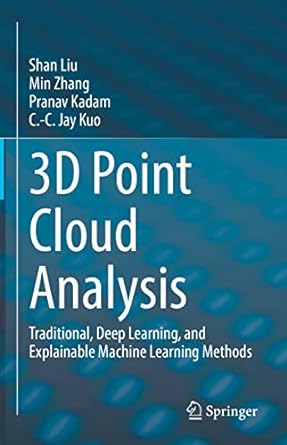
Download the free Kindle app and start reading Kindle books instantly on your smartphone, tablet, or computer - no Kindle device required.
Read instantly on your browser with Kindle for Web.
Using your mobile phone camera - scan the code below and download the Kindle app.

3D Point Cloud Analysis: Traditional, Deep Learning, and Explainable Machine Learning Methods 1st ed. 2021 Edition
Purchase options and add-ons
This book introduces the point cloud; its applications in industry, and the most frequently used datasets. It mainly focuses on three computer vision tasks -- point cloud classification, segmentation, and registration -- which are fundamental to any point cloud-based system. An overview of traditional point cloud processing methods helps readers build background knowledge quickly, while the deep learning on point clouds methods include comprehensive analysis of the breakthroughs from the past few years. Brand-new explainable machine learning methods for point cloud learning, which are lightweight and easy to train, are then thoroughly introduced. Quantitative and qualitative performance evaluations are provided. The comparison and analysis between the three types of methods are given to help readers have a deeper understanding.
With the rich deep learning literature in 2D vision, a natural inclination for 3D vision researchers is to develop deep learning methods for point cloud processing. Deep learning on point clouds has gained popularity since 2017, and the number of conference papers in this area continue to increase. Unlike 2D images, point clouds do not have a specific order, which makes point cloud processing by deep learning quite challenging. In addition, due to the geometric nature of point clouds, traditional methods are still widely used in industry. Therefore, this book aims to make readers familiar with this area by providing comprehensive overview of the traditional methods and the state-of-the-art deep learning methods.
A major portion of this book focuses on explainable machine learning as a different approach to deep learning. The explainable machine learning methods offer a series of advantages over traditional methods and deep learning methods. This is a main highlight and novelty of the book. By tackling three research tasks -- 3D object recognition, segmentation, and registration using our methodology -- readers will have a sense of how to solve problems in a different way and can apply the frameworks to other 3D computer vision tasks, thus give them inspiration for their own future research.
Numerous experiments, analysis and comparisons on three 3D computer vision tasks (object recognition, segmentation, detection and registration) are provided so that readers can learn how to solve difficult Computer Vision problems.
- ISBN-103030891798
- ISBN-13978-3030891794
- Edition1st ed. 2021
- PublisherSpringer
- Publication dateDecember 11, 2021
- LanguageEnglish
- Dimensions6.14 x 0.44 x 9.21 inches
- Print length160 pages
Editorial Reviews
From the Back Cover
With the rich deep learning literature in 2D vision, a natural inclination for 3D vision researchers is to develop deep learning methods for point cloudprocessing. Deep learning on point clouds has gained popularity since 2017, and the number of conference papers in this area continue to increase. Unlike 2D images, point clouds do not have a specific order, which makes point cloud processing by deep learning quite challenging. In addition, due to the geometric nature of point clouds, traditional methods are still widely used in industry. Therefore, this book aims to make readers familiar with this area by providing comprehensive overview of the traditional methods and the state-of-the-art deep learning methods.
A major portion of this book focuses on explainable machine learning as a different approach to deep learning. The explainable machine learning methods offer a series of advantages over traditional methods and deep learning methods. This is a main highlight and novelty of the book. By tackling three research tasks -- 3D object recognition, segmentation, and registration using our methodology -- readers will have a sense of how to solve problems in a different way and can apply the frameworks to other 3D computer vision tasks, thus give them inspiration for their own future research.
Numerous experiments, analysis and comparisons on three 3D computer vision tasks (object recognition, segmentation, detection and registration) are provided so that readers can learn how to solve difficult Computer Vision problems.
About the Author
Shan Liu received her B.Eng. degree in electronic engineering from Tsinghua University, and M.S. and Ph.D. degrees in electrical engineering from the University of Southern California, respectively. She is currently a Distinguished Scientist at Tencent and General Manager of Tencent Media Lab. She was formerly Director of Media Technology Division at MediaTek USA. She was also formerly with MERL and Sony, etc. Dr. Liu has been an active contributor to international standards for more than a decade. She has numerous technical proposals adopted into various standards, such as H.266/VVC, H.265/HEVC, OMAF, DASH, MMT, PCC, and served as an Editor of H.265/HEVC SCC and H.266/VVC standards. She is also heavily involved in multimedia technology productization and made instrumental contributions to several million-user products. Dr. Liu holds more than 200 granted patents and has published more than 100 technical papers. She was named “APSIPA Industrial Distinguished Leader” by Asia-Pacific Signal and Information Processing Association in 2018, and “50 Women in Tech” by Forbes China in 2020. She is on the Editorial Board of IEEE Transactions on Circuits and Systems for Video Technology (2018-present) and received the Best AE Award in 2019 and 2020, respectively. Her research interests include audio-visual, volumetric, immersive and emerging media compression, intelligence, transport and systems.
Min Zhang received her B.E. degree from the School of Science, Nanjing University of Science and Technology, Nanjing, China and her M.S. degree from the Viterbi School of Engineering, University of Southern California (USC), Los Angeles, US, in 2017 and 2019, respectively. She joined Media Communications Laboratory (MCL) in 2018 summer and is currently a Ph.D. student in USC, guided by Prof. C.-C. Jay Kuo. Her research interests include point cloud processing and analysis related problems, i.e., point cloud classification, registration, and segmentation and detection, in the field of 3D computer vision, machine learning, and perception.
Pranav Kadam received his MS degree in Electrical Engineering from the University of Southern California, Los Angeles, USA in 2020, and the Bachelor’s degree in Electronics and Telecommunication Engineering from Savitribai Phule Pune University, Pune, India in 2018. He is currently pursuing the PhD degree in Electrical Engineering from the University of Southern California. He is actively involved in research and development of methods for point cloud analysis and processing. His research interests include 3D computer vision, machine learning, and perception.
C.-C. Jay Kuo received the Ph.D. degree in electrical engineering from the Massachusetts Institute of Technology, Cambridge in 1987. He is currently the holder of William M. Hogue Professorship, a Distinguished Professor of Electrical and Computer Engineering and Computer Science, and the Director of the USC Multimedia Communications Laboratory (MCL) at the University of Southern California. Dr. Kuo is a Fellow of the American Association for the Advancement of Science (AAAS), the Institute of Electrical and Electronics Engineers (IEEE), the National Academy of Inventors (NAI), and the International Society for Optical Engineers (SPIE). He has received several awards for his research contributions, including the 2010 Electronic Imaging Scientist of the Year Award, the 2010-11 Fulbright-Nokia Distinguished Chair in Information and Communications Technologies, the 2011 Pan Wen-Yuan Outstanding Research Award, the 2019 IEEE Computer Society Edward J. McCluskey Technical Achievement Award, the 2019 IEEE Signal Processing Society Claude Shannon-Harry Nyquist Technical Achievement Award, the 2020 IEEE TCMC Impact Award, the 72nd annual Technology and Engineering Emmy Award (2020), and the 2021 IEEE Circuits and Systems Society Charles A. Desoer Technical Achievement Award.
Product details
- Publisher : Springer; 1st ed. 2021 edition (December 11, 2021)
- Language : English
- Hardcover : 160 pages
- ISBN-10 : 3030891798
- ISBN-13 : 978-3030891794
- Item Weight : 14.5 ounces
- Dimensions : 6.14 x 0.44 x 9.21 inches
- Best Sellers Rank: #4,090,001 in Books (See Top 100 in Books)
- #355 in 3D Graphic Design
- #891 in Computer Vision & Pattern Recognition
- #1,222 in Artificial Intelligence (Books)
- Customer Reviews:
Customer reviews
Customer Reviews, including Product Star Ratings help customers to learn more about the product and decide whether it is the right product for them.
To calculate the overall star rating and percentage breakdown by star, we don’t use a simple average. Instead, our system considers things like how recent a review is and if the reviewer bought the item on Amazon. It also analyzed reviews to verify trustworthiness.
Learn more how customers reviews work on Amazon


